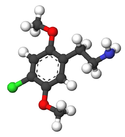2C-C

| |||
| |||
| Names | |||
|---|---|---|---|
| Preferred IUPAC name
2-(4-Chloro-2,5-dimethoxyphenyl)ethan-1-amine | |||
| Other names
(4-Chloro-2,5-dimethoxyphenethyl)amine
| |||
| Identifiers | |||
3D model (JSmol)
|
|||
| ChEMBL | |||
| ChemSpider | |||
PubChem CID
|
|||
| UNII | |||
CompTox Dashboard (EPA)
|
|||
| |||
| |||
| Properties | |||
| C10H14ClNO2 | |||
| Molar mass | 215.6778 g/mol | ||
| Melting point | 220 to 221 °C (428 to 430 °F; 493 to 494 K) (hydrochloride) | ||
Except where otherwise noted, data are given for materials in their standard state (at 25 °C [77 °F], 100 kPa).
| |||
2C-C is a psychedelic drug of the 2C family. It was first synthesized by Alexander Shulgin, sometimes used as an entheogen. In his book PiHKAL (Phenethylamines i Have Known And Loved), Shulgin lists the dosage range as 20–40 mg. 2C-C is usually taken orally, but may also be insufflated.[1] 2C-C is schedule I of section 202(c) of the Controlled Substances Act in the United States, signed into law as of July, 2012 under the Food and Drug Administration Safety and Innovation Act.[2]
Not much information is known about the toxicity of 2C-C.
Effects
This section needs more reliable medical references for verification or relies too heavily on primary sources. (June 2014) |  |
- The visual effects of 2C-C are similar to those of LSD or psilocybin mushrooms, though much less intense at commonly taken doses. Unique among the psychedelics, 2C-C is intensely relaxing, almost sedating.[citation needed] Nasal insufflation (extremely painful) or rectal administration bypasses first pass metabolism, requiring about half the dose normally used orally; the effects occur within 2–30 minutes via these routes and tend to last about an hour or two.
- The effects can take up to two hours to manifest.
- Over the approximate dose range 20–40 mg, effects last respectively, approximately, 4 to 8 hours. Increased dosages increase the duration of the trip.[1]
Drug prohibition laws
China
As of October 2015 2C-C is a controlled substance in China.[3]
Canada
As of October 31st, 2016; 2C-C is a controlled substance (Schedule III) in Canada. http://gazette.gc.ca/rp-pr/p2/2016/2016-05-04/html/sor-dors72-eng.php
Germany
2C-C is a Anlage I controlled drug.
Sweden
Sveriges riksdags health ministry Statens folkhälsoinstitut classified 2C-C as "health hazard" under the act Lagen om förbud mot vissa hälsofarliga varor (translated Act on the Prohibition of Certain Goods Dangerous to Health) as of Mar 1, 2005, in their regulation SFS 2005:26 listed as 2,5-dimetoxi-4-klorfenetylamin (2C-C), making it illegal to sell or possess.[4]
USA
As of July 9, 2012, in the United States 2C-C is a Schedule I substance under the Food and Drug Administration Safety and Innovation Act of 2012, making possession, distribution and manufacture illegal.[5]
See also
References
- ^ a b Shulgin, Alexander; Shulgin, Ann (September 1991). PiHKAL: A Chemical Love Story. Berkeley, California: Transform Press. ISBN 0-9630096-0-5. OCLC 25627628.
- ^ "S. 3187: Food and Drug Administration Safety and Innovation Act, Subtitle D-Synthetic Drugs". FDA. June 27, 2012. Retrieved July 12, 2012.
- ^ "关于印发《非药用类麻醉药品和精神药品列管办法》的通知" (in Chinese). China Food and Drug Administration. 27 September 2015. Retrieved 1 October 2015.
- ^ http://www.notisum.se/rnp/sls/sfs/20050026.pdf
- ^ Erowid.org, Legal Status of 2C-C


